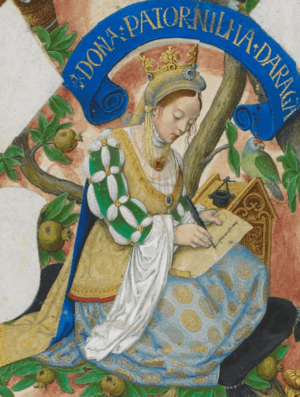Petronilla of Aragon facts for kids
Quick facts for kids Petronilla |
|
|---|---|

Petronilla as imagined by António de Holanda in the early 1530s
|
|
| Queen of Aragon | |
| Reign | 16 August 1137 – 18 July 1164 |
| Predecessor | Ramiro II |
| Successor | Alfonso II |
| Born | 29 June 1136 Huesca |
| Died | 15 October 1173 (aged 37) Barcelona |
| Burial | Barcelona Cathedral |
| Spouse | Ramon Berenguer IV, Count of Barcelona |
| Issue | |
| House | Jiménez |
| Father | Ramiro II of Aragon |
| Mother | Agnes of Aquitaine |
| Religion | Roman Catholicism |
Petronilla (born June 29, 1136 – died October 15, 1173) was the Queen of Aragon. She ruled from 1137 until 1164. Her father, Ramiro II of Aragon, gave up his throne to her. After she stepped down, she helped rule as a regent for her young son. Petronilla was the last queen from the Jiménez dynasty in Aragon. Her marriage helped bring the House of Barcelona to the throne.
Contents
Becoming Queen: Petronilla's Early Life
Petronilla became queen because of some special events. Her father, Ramiro, was a bishop. His brother, Alfonso the Battler, died in 1134 without children. Alfonso wanted to leave his crown to three religious groups. But the nobles did not agree.
The nobles of Navarre chose their own king. This made their kingdom independent again. The nobles of Aragon then chose Ramiro to be their king. To have a child and secure the throne, King Ramiro was allowed to leave his life as a monk. He married Agnes of Aquitaine in 1135. Their only child, Petronilla, was born in Huesca the next year.
Petronilla's marriage was very important for the kingdom. When she was just over one year old, she was promised to Ramon Berenguer IV, Count of Barcelona. This happened in Barbastro in 1137. Ramon Berenguer was 23 years older than her.
Queen of Aragon: Her Reign
In 1137, her father Ramiro gave up his power to Ramon Berenguer. Ramiro then went back to being a monk. Ramon Berenguer ruled Aragon. He used the title "Prince of the Aragonese."
In 1150, when Petronilla was 14, she officially married Ramon Berenguer in Lleida. They had five children together. The first child was Peter, followed by Raymond Berengar, Peter, Dulce, and Sancho.
While she was pregnant with her first child, Petronilla wrote a will. She said that if she did not survive childbirth, her kingdom would go to her husband.
Petronilla stayed in Barcelona while her husband was away. He was in Provence, helping to rule there. Records show she moved between Barcelona and other towns. She was in charge of the court while her husband was gone.
After her husband died in 1162, Petronilla received some land for her lifetime. This included the rich County of Besalú. For two years, she was the only ruler of Aragon.
Helping Her Son: Petronilla as Regent
Petronilla's oldest son was seven years old. In 1164, she gave up her throne to him. When her son Raymond Berengar became king, he changed his name to Alfonso. He did this to honor the Aragonese people. Her second son, Peter, then changed his name to Raymond Berenguer.
Since her son was so young, Petronilla continued to rule. She acted as his regent. This meant she helped him make decisions until he was old enough to rule alone.
Petronilla died in Barcelona in October 1173. She was buried at Barcelona Cathedral. Her tomb is now lost. After her death, the lands she had received went back to her son, King Alfonso.
Petronilla's Lasting Impact
Petronilla's role was very important for Aragon's future. Later, in 1410, King Martin died without children. This meant the House of Barcelona family line ended for kings.
Two years later, Ferdinand I of Aragon became king. He was chosen because he was related to King Martin through a woman. Petronilla's rule helped show that a woman could pass on the right to rule to her children. This was a key reason why Ferdinand could become king.
There has been some discussion about whether Petronilla was the true ruler of Aragon. Some people thought her father gave the kingdom directly to her husband. However, the way Ferdinand became king later confirmed that women could pass on their right to the throne.
Images for kids
See also
 In Spanish: Petronila I de Aragón para niños
In Spanish: Petronila I de Aragón para niños


